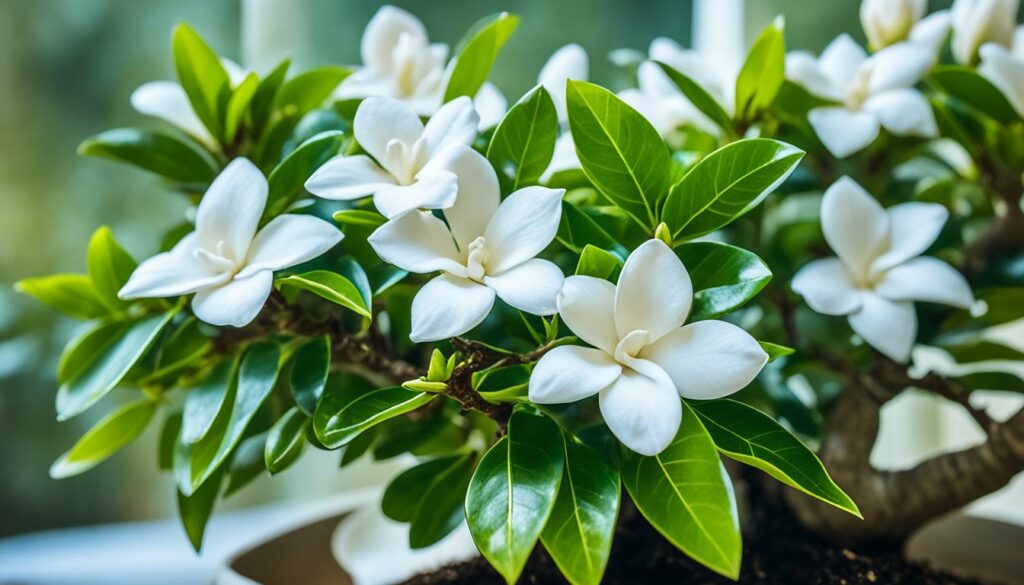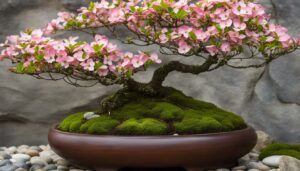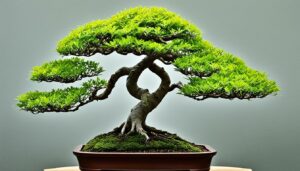If you are looking for a way to add serenity and beauty to your space, the Gardenia bonsai tree species may be just what you need. Known for its fragrant blooms and stunning appearance, the Gardenia bonsai is a popular choice for those looking to create a peaceful atmosphere indoors or out.
The Gardenia bonsai species is among the most favored bonsai tree species, featuring lush green leaves and delightful aromatic blooms that can transform any space into a fragrant centerpiece. It’s a visually stunning plant that adds a touch of elegance and class to any home or landscape.
Key Takeaways:
- Gardenia bonsai trees are fragrant centerpieces that add serenity to any space
- The Gardenia bonsai species is popular for its aromatic blooms and lush green leaves
- It’s a visually stunning plant that adds elegance and class to any setting
- To maintain the health and longevity of your Gardenia bonsai, proper care and maintenance are essential
- Creating the ideal environment and applying correct training techniques can help you showcase the beauty of your Gardenia bonsai
Understanding Bonsai Trees
Bonsai trees, the art of nurturing miniature trees that resemble full-grown trees, have been enjoyed for centuries. Cultivating a Bonsai tree is a challenging hobby that requires patience, attention to detail, and a genuine love of nature.
At the core of Bonsai tree cultivation is the careful selection of a tree species that can thrive in miniature form. There are numerous species to choose from, each with its own unique features. One such species is the Gardenia bonsai, treasured for its beautiful and fragrant flowers.
Bonsai trees may be deciduous or evergreen, and each species has its own specific environmental requirements. The Gardenia bonsai, being a flowering bonsai, demands extra attention when it comes to light exposure and watering.
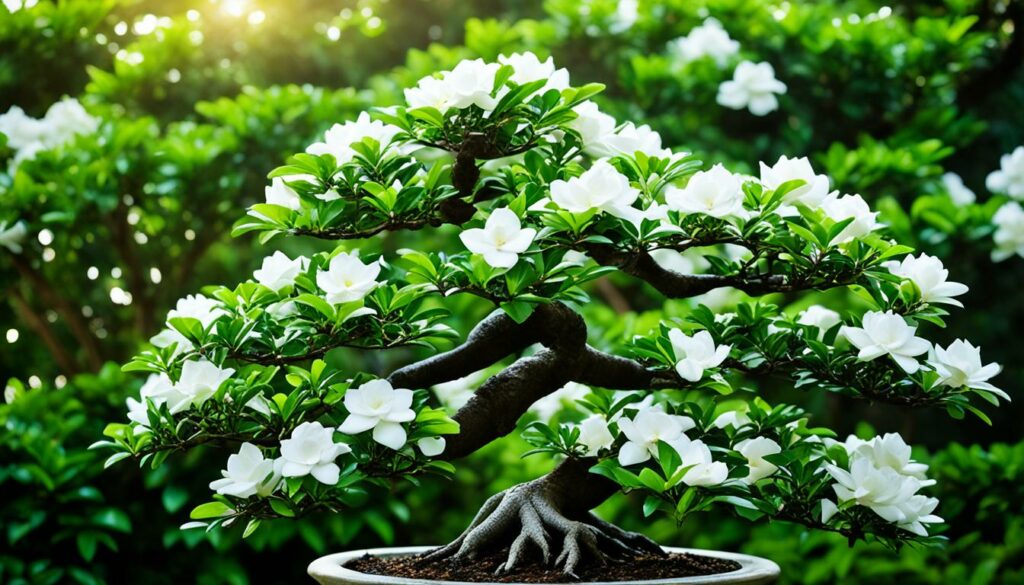
While it takes time and effort to cultivate a Bonsai tree, the end result is a breathtaking, living piece of art that brings serenity and beauty to your indoor or outdoor space.
The Enchanting Gardenia Bonsai
If you’re looking for a bonsai tree species that can add a touch of beauty and serenity to any space, look no further than the Gardenia bonsai. This captivating miniature tree is known for its enchanting beauty and unique characteristics, making it a popular choice among bonsai enthusiasts.
One of the most significant features of the Gardenia bonsai is its fragrant blooms, which emit a beautiful aroma that can transform any environment into an aromatic oasis. This bonsai type’s captivating scent makes it an ideal choice as a fragrant centerpiece in any space, adding both natural beauty and a refreshing scent.
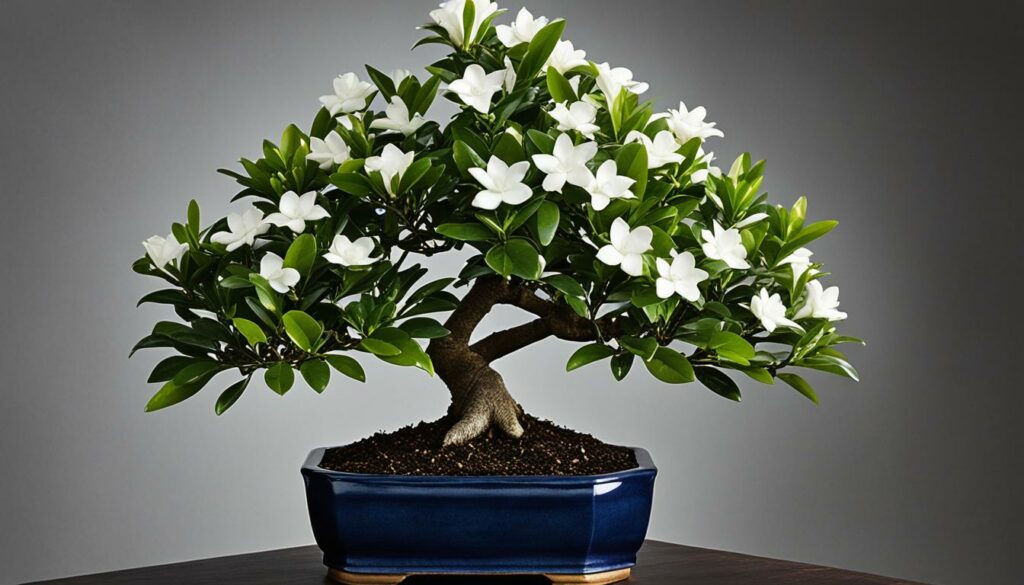
The Gardenia bonsai is also an aromatic bonsai, meaning it offers many therapeutic benefits to those around it. The scent of this beautiful miniature tree has a calming effect on the mind and body, promoting relaxation and reducing anxiety.
While the Gardenia bonsai does require some extra maintenance compared to other bonsai tree species, the rewards are well worth the effort. This bonsai type’s fragrant blooms and unique characteristics make it a standout choice for adding a touch of natural beauty and serenity to any space.
Care and Maintenance
Proper care and maintenance are essential for the health and longevity of your Gardenia bonsai. Here are some guidelines to follow:
- Watering: Keep the soil moist but not waterlogged. Water your Gardenia bonsai deeply, allowing excess water to drain away.
- Fertilizing: Use a balanced fertilizer specifically formulated for bonsai trees, applied every two to four weeks during the growing season.
- Pruning: Regular pruning is necessary to maintain the desired shape and size of your Gardenia bonsai. Prune after flowering is complete and remove any dead or diseased branches.
- Repotting: Repot your Gardenia bonsai every two to three years in early spring, using a well-draining soil mix. This will allow for proper root growth and development.
By following these guidelines, your Gardenia bonsai will thrive and continue to provide you with its fragrant blooms for years to come.
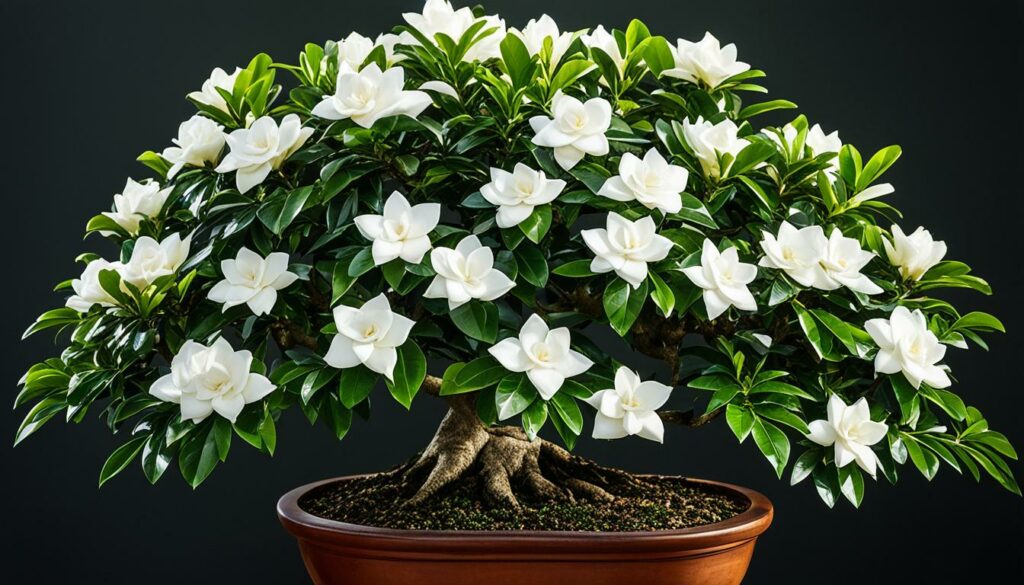
Creating the Ideal Environment
To ensure that your Gardenia bonsai thrives and produces fragrant blooms, it’s crucial to create the perfect environment. Here are some factors to consider:
| Factor | Optimal Condition |
|---|---|
| Light | Partial sunlight – 4-6 hours of direct sunlight daily |
| Temperature | 60-70°F during the daytime, no lower than 56°F at night |
| Humidity | Higher humidity – around 60-70% – can be achieved with a humidifier or by placing the bonsai on a tray of wet pebbles |
| Air Circulation | Adequate air circulation – avoid placing the bonsai near vents, fans or air conditioners |
Proper lighting is essential for the development of healthy foliage and blooms. A bright, but not overly sunny location, ideally an east-facing window, is an ideal environment for your Gardenia bonsai to thrive. Be sure to rotate the bonsai regularly to ensure even growth, as the plant will tend to grow towards the light source.
Temperature is another vital component in ensuring your Gardenia bonsai thrives. Keep the temperature consistent and avoid placing the bonsai in drafty areas.
Humidity is a crucial factor in ensuring your Gardenia bonsai produces lush and healthy blooms. Providing adequate humidity is especially important during the winter months when air can be particularly dry.
Finally, it’s important to consider air circulation. Adequate air circulation is important for maintaining optimal growing conditions and prevents stagnant air from harming the bonsai.
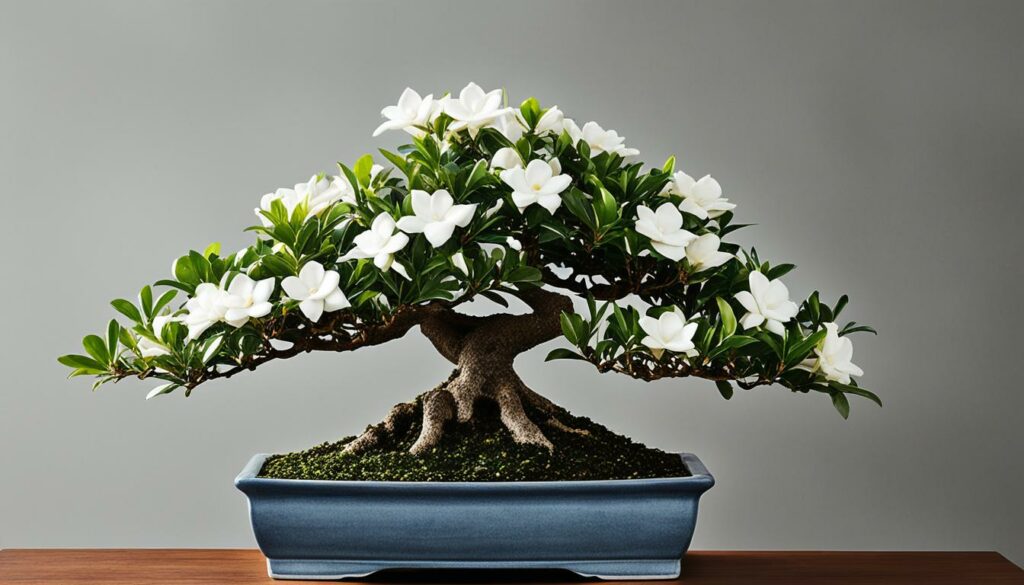
Creating the ideal environment for your Gardenia bonsai might require some effort, but it’s worth it for the fragrant centerpiece that you’ll have in your home or garden. With proper care, your Gardenia bonsai will flourish and produce aromatic blooms that brighten your day and add a touch of serenity to your space.
Training Techniques for Gardenia Bonsai
If you want to create a unique and visually appealing design for your Gardenia bonsai while maintaining its natural beauty and fragrance, you can use various training techniques. These techniques include:
- Wiring: This technique involves wrapping wire around the branches and trunk of the bonsai to shape it according to your desired design. However, you should be careful not to wire the branches too tightly, as it can cause damage.
- Pruning: Proper pruning is necessary to maintain the health and shape of your Gardenia bonsai. Cut the branches and leaves that are unhealthy and unwanted to allow the remaining plant to grow and flourish.
- Shaping: Shaping involves bending the branches of your Gardenia bonsai into the desired direction and position. You can do this by gently using your hands or using wire to hold the branches in the right place until they set into position.
These techniques require patience, practice, and a careful hand to maintain the beauty and charm of your Gardenia bonsai. A well-trained Gardenia bonsai can be a true work of art and a fragrant centerpiece in your home or garden.
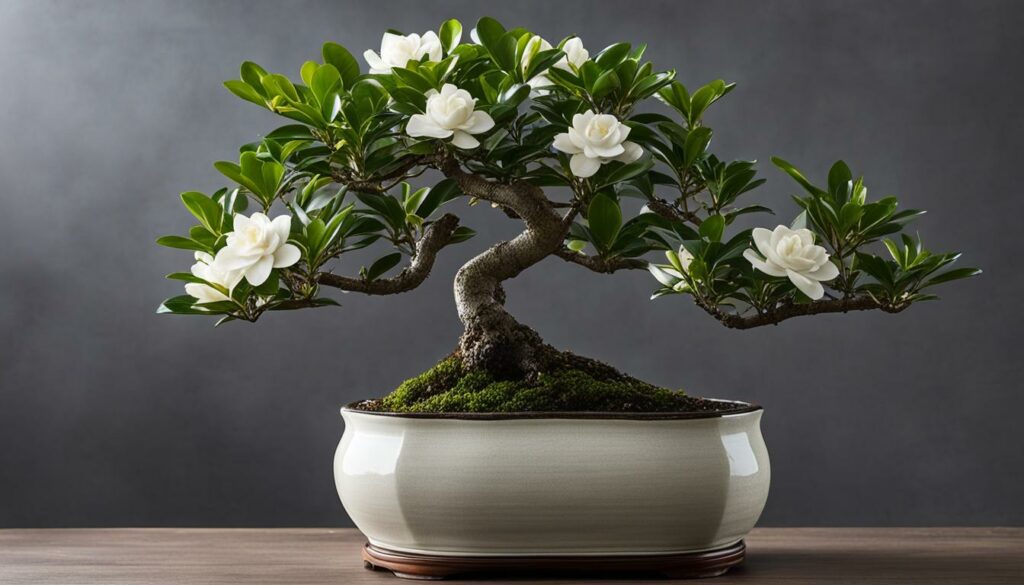
Common Issues and Solutions
Despite their beauty, Gardenia bonsai trees can be susceptible to certain issues that can affect their health. It is essential to be familiar with these common problems and their solutions to ensure that your bonsai tree stays healthy and vibrant.
Pests
Gardenia bonsai trees can be targeted by various pests, including scales, spider mites, and mealybugs. Visible signs of pest infestation include yellowing or browning of leaves and growths on the foliage. One effective solution is to spray the entire tree, including the undersides of leaves, with a diluted solution of neem oil.
Diseases
Another common issue that Gardenia bonsai trees can face is diseases such as root rot and leaf spot. These diseases are often caused by poor drainage and overwatering. To treat root rot, remove the tree from its pot and carefully cut away any mushy or rotting roots. For leaf spot, it is necessary to apply a copper-based fungicide to the affected leaves.
Nutrient Deficiencies
Gardenia bonsai trees require certain nutrients to grow and flourish. Lack of nutrients can cause problems such as stunted growth and yellowing leaves. To rectify this issue, it is necessary to apply a balanced fertilizer specifically formulated for Gardenia bonsai trees and follow the instructions accordingly.
By being proactive in addressing these common issues, you can help your Gardenia bonsai tree thrive and enjoy its full range of beauty and fragrance.
Showcasing Gardenia Bonsai
Now that you have your beautiful Gardenia bonsai, it’s time to showcase its unique charm and fragrance. Here are some suggestions on incorporating your Gardenia bonsai into your indoor or outdoor spaces:
- Place your Gardenia bonsai in a prominent location, such as on a coffee table or bookshelf. Its fragrant blooms will create a stunning centerpiece that adds charm and serenity to any room.
- Create a beautiful garden display by combining your Gardenia bonsai with other flowering plants. Its aromatic presence will transform your outdoor space into a fragrant oasis.
- Consider using your Gardenia bonsai as a focal point for special events, such as weddings or parties. Its beauty and fragrance will add an elegant touch to any occasion.
Whatever your preference, there are many ways to incorporate your Gardenia bonsai into your space and highlight its unique features.
Above all, enjoy your Gardenia bonsai and appreciate the beauty and serenity it brings.
Gardenia Bonsai in Different Styles
Gardenia bonsai trees can be styled in various ways to create unique designs that enhance their overall appearance. By carefully pruning and wiring the branches, you can create a bonsai that reflects your personal style and taste. Here are a few common bonsai styles you can use to inspire your own creations:
Formal upright
The formal upright style is characterized by a straight, tapering trunk and symmetrical branching. This style showcases the natural beauty of the Gardenia bonsai and is perfect for showcasing its fragrant blooms.
Informal upright
The informal upright style is less structured than the formal upright, with a more sinuous trunk and branching. This style allows you to create a more naturalistic look, highlighting the Gardenia’s graceful beauty.
Slanting
In the slanting style, the trunk is slanted at an angle, creating a dynamic and interesting design. This style is ideal for displaying the Gardenia bonsai’s flowering branches in an eye-catching way.
Cascade
The cascade style is dramatic and visually appealing, with the branches flowing downward in a cascade effect. This style creates a unique centerpiece that draws attention to the Gardenia bonsai’s exquisite blooms.
Whichever style you choose, remember to take your time and work carefully to create the perfect Gardenia bonsai. With patience and attention to detail, you can create a bonsai that is a true work of art.
Conclusion
Now that you understand the unique qualities of the Gardenia bonsai, you can appreciate its ability to transform any space into a fragrant and serene environment. As a bonsai tree species, the Gardenia bonsai is a perfect choice for those who appreciate the art form and beauty of miniature trees.
By following the care and maintenance guidelines discussed in this article, you can ensure the health and longevity of your Gardenia bonsai. With proper training techniques and optimal environmental conditions, you can create a visually captivating and aromatic centerpiece that will impress your guests.
Remember that Gardenia bonsai trees are versatile and can be showcased in various styles and settings, from indoor spaces to outdoor gardens. Whether you are an experienced bonsai enthusiast or a novice, the Gardenia bonsai is a perfect addition to any collection.
Thank you for reading this article on the Gardenia bonsai tree species. We hope it has inspired you to explore the world of bonsai and appreciate the allure of this fragrant and enchanting bonsai tree species, the Gardenia bonsai.
FAQ
What is a Gardenia bonsai?
A Gardenia bonsai is a miniature tree cultivated from the Gardenia species. It is known for its beautiful flowers and fragrant blooms, making it a captivating centerpiece in any space.
How do I care for a Gardenia bonsai?
Caring for a Gardenia bonsai involves regular watering, providing adequate light and temperature, and fertilizing appropriately. It is also important to prune and repot the bonsai when needed to maintain its health and appearance.
Can I keep a Gardenia bonsai indoors?
Yes, a Gardenia bonsai can be kept indoors. However, it requires proper light and humidity to thrive. Placing it near a sunny window and using a humidity tray can help create a suitable environment for the bonsai.
How often should I water my Gardenia bonsai?
The watering frequency for a Gardenia bonsai depends on various factors such as the climate, pot size, and soil type. Generally, it is recommended to water the bonsai when the topsoil feels slightly dry, ensuring that the roots do not dry out completely.
What should I do if my Gardenia bonsai doesn’t flower?
Lack of flowering in a Gardenia bonsai can be caused by various factors such as insufficient light, improper temperature, or incorrect pruning techniques. Ensuring the bonsai receives adequate light and maintaining appropriate temperature conditions can help stimulate flower production.
How can I shape my Gardenia bonsai?
Shaping a Gardenia bonsai can be achieved through techniques such as wiring and pruning. Wiring helps guide the growth of branches, while pruning allows you to remove unwanted branches or shape the overall design of the bonsai.
What are some common issues with Gardenia bonsai?
Common issues with Gardenia bonsai include pests such as aphids and mealybugs, diseases like root rot or leaf spot, and nutrient deficiencies. Regularly inspecting the bonsai and addressing any issues promptly can help maintain its health.
Can I use fertilizer on my Gardenia bonsai?
Yes, fertilizing is an essential part of caring for a Gardenia bonsai. Using a balanced bonsai fertilizer according to the instructions provided can help provide the necessary nutrients for healthy growth and vibrant blooms.
How long does it take for a Gardenia bonsai to bloom?
The time it takes for a Gardenia bonsai to bloom can vary depending on various factors such as the age and health of the bonsai, as well as the care it receives. Generally, with proper care, a Gardenia bonsai can start blooming within 1-2 years.
Can I create my own bonsai style with a Gardenia bonsai?
Yes, you can create your own bonsai style with a Gardenia bonsai. Bonsai styling involves shaping the bonsai according to your vision and aesthetic preferences. It is a creative process that allows you to express your individuality while maintaining the natural beauty of the Gardenia bonsai.
